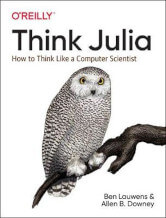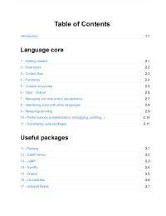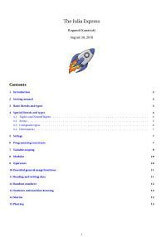Julia is a high-level, high-performance dynamic programming language for technical computing by Alan Edelman, Stefan Karpinski, Jeff Bezanson, and Viral Shah. Julia aims to create an unprecedented combination of ease-of-use, power, and efficiency in a single language.
It’s a homoiconic functional language focused on technical computing. While having the full power of homoiconic macros, first-class functions, and low-level control, Julia is as easy to learn and use as Python.
Although Julia is a new language, first appearing in 2012, its roots are in Lisp, so it comes with mature features like macros and support for other metaprogramming techniques like code generation. Julia’s expressive grammar lets you write easy-to-read and easier-to-debug code, and its speed gets you through more work in less time. It’s a great choice whether you’re designing a machine learning system, crunching statistical data, or writing system utilities.
Distinctive aspects of Julia’s design include a type system with parametric polymorphism and types in a fully dynamic programming language and multiple dispatch as its core programming paradigm. It allows concurrent, parallel and distributed computing, and direct calling of C and Fortran libraries without glue code.
Because Julia is a relatively new language there are relatively limited resources to help you get started with it besides the official documentation. But we’ve researched the finest open source resources to help you master the language.
1. Think Julia: How to Think Like a Computer Scientist by Allen Downey, Ben Lauwens

Julia is a unique programming language because it solves the so-called “two languages problem.” No other programming language is needed to write high-performance code. This does not mean it happens automatically. It’s the responsibility of the programmer to optimize the code that forms a bottleneck, but this can done in Julia itself.
This book is for anyone who wants to learn to program. No formal prior knowledge is required.
New concepts are introduced gradually and more advanced topics are described in later chapters.
Think Julia can be used for a one-semester course at the high school or college level.
Think Julia is available under the Creative Commons Attribution-NonCommercial 3.0 Unported License.
2. Julia Language: A Concise Tutorial by Antonello Lobianco
 The purposes of this tutorial are (a) to store things the author has learned himself about Julia and (b) to help those who want to start coding in Julia before reading official documentation.
The purposes of this tutorial are (a) to store things the author has learned himself about Julia and (b) to help those who want to start coding in Julia before reading official documentation.
Chapters cover:
Language core:
- Getting started.
- Data types.
- Control flow.
- Functions.
- Custom structures.
- Input – Output.
- Managing run-time errors (exceptions).
- Interfacing Julia with other languages.
- Metaprogramming.
- Performances (parallelisation, debugging, profiling…).
- Developing Julia packages.
Useful packages:
- Plotting.
- DataFrames.
- JuMP.
- SymPy.
- Weave.
- LAJuliaUtils.
- IndexedTables.
License details are not specified.
3. The Julia Express by Bogumił Kaminski
 The purpose of this document is to introduce programmers to Julia programming by example. This short book is a simplified exposition of the language.
The purpose of this document is to introduce programmers to Julia programming by example. This short book is a simplified exposition of the language.
This is an introductory document. Important topics that a person learning the Julia should be aware of, that are not covered are: parametric types, parallel and distributed processing, advanced I/O operations, advanced package management, interaction with system shell, exception handling, creation of coroutines, and integration with C, Fortran, Python and R.
Chapters cover:
- Basic literals and types.
- Special literals and types;
- Strings.
- Programming constructs.
- Variable scoping
- Modules.
- Operators.
- Essential general usage functions.
- Reading and writing data.
- Random numbers.
- Statistics and machine learning
- Macros.
- Plotting
The Julia Express is published under the MIT License.
Next page: Page 2 – The Julia Language and more books
Pages in this article:
Page 1 – Think Julia: How to Think Like a Computer Scientist and more books
Page 2 – The Julia Language and more books
All books in this series:
| Free Programming Books | |
|---|---|
| Ada | ALGOL-like programming language, extended from Pascal and other languages |
| Agda | Dependently typed functional language based on intuitionistic Type Theory |
| Arduino | Inexpensive, flexible, open source microcontroller platform |
| Assembly | As close to writing machine code without writing in pure hexadecimal |
| Awk | Versatile language designed for pattern scanning and processing language |
| Bash | Shell and command language; popular both as a shell and a scripting language |
| BASIC | Beginner’s All-purpose Symbolic Instruction Code |
| C | General-purpose, procedural, portable, high-level language |
| C++ | General-purpose, portable, free-form, multi-paradigm language |
| C# | Combines the power and flexibility of C++ with the simplicity of Visual Basic |
| Clojure | Dialect of the Lisp programming language |
| ClojureScript | Compiler for Clojure that targets JavaScript |
| COBOL | Common Business-Oriented Language |
| CoffeeScript | Transcompiles into JavaScript inspired by Ruby, Python and Haskell |
| Coq | Dependently typed language similar to Agda, Idris, F* and others |
| Crystal | General-purpose, concurrent, multi-paradigm, object-oriented language |
| CSS | CSS (Cascading Style Sheets) specifies a web page’s appearance |
| D | General-purpose systems programming language with a C-like syntax |
| Dart | Client-optimized language for fast apps on multiple platforms |
| Dylan | Multi-paradigm language supporting functional and object-oriented coding |
| ECMAScript | Best known as the language embedded in web browsers |
| Eiffel | Object-oriented language designed by Bertrand Meyer |
| Elixir | Relatively new functional language running on the Erlang virtual machine |
| Erlang | General-purpose, concurrent, declarative, functional language |
| F# | Uses functional, imperative, and object-oriented programming methods |
| Factor | Dynamic stack-based programming language |
| Forth | Imperative stack-based programming language |
| Fortran | The first high-level language, using the first compiler |
| Go | Compiled, statically typed programming language |
| Groovy | Powerful, optionally typed and dynamic language |
| Haskell | Standardized, general-purpose, polymorphically, statically typed language |
| HTML | HyperText Markup Language |
| Icon | Wide variety of features for processing and presenting symbolic data |
| J | Array programming language based primarily on APL |
| Java | General-purpose, concurrent, class-based, object-oriented, high-level language |
| JavaScript | Interpreted, prototype-based, scripting language |
| Julia | High-level, high-performance language for technical computing |
| Kotlin | More modern version of Java |
| LabVIEW | Designed to enable domain experts to build power systems quickly |
| LaTeX | Professional document preparation system and document markup language |
| Lisp | Unique features - excellent to study programming constructs |
| Logo | Dialect of Lisp that features interactivity, modularity, extensibility |
| Lua | Designed as an embeddable scripting language |
| Markdown | Plain text formatting syntax designed to be easy-to-read and easy-to-write |
| Objective-C | Object-oriented language that adds Smalltalk-style messaging to C |
| OCaml | The main implementation of the Caml language |
| Pascal | Imperative and procedural language designed in the late 1960s |
| Perl | High-level, general-purpose, interpreted, scripting, dynamic language |
| PHP | PHP has been at the helm of the web for many years |
| PostScript | Interpreted, stack-based and Turing complete language |
| Prolog | A general purpose, declarative, logic programming language |
| PureScript | Small strongly, statically typed language compiling to JavaScript |
| Python | General-purpose, structured, powerful language |
| QML | Hierarchical declarative language for user interface layout - JSON-like syntax |
| R | De facto standard among statisticians and data analysts |
| Racket | General-purpose, object-oriented, multi-paradigm, functional language |
| Raku | Member of the Perl family of programming languages |
| Ruby | General purpose, scripting, structured, flexible, fully object-oriented language |
| Rust | Ideal for systems, embedded, and other performance critical code |
| Scala | Modern, object-functional, multi-paradigm, Java-based language |
| Scheme | A general-purpose, functional language descended from Lisp and Algol |
| Scratch | Visual programming language designed for 8-16 year-old children |
| SQL | Access and manipulate data held in a relational database management system |
| Standard ML | General-purpose functional language characterized as "Lisp with types" |
| Swift | Powerful and intuitive general-purpose programming language |
| Tcl | Dynamic language based on concepts of Lisp, C, and Unix shells |
| TeX | Markup and programming language - create professional quality typeset text |
| TypeScript | Strict syntactical superset of JavaScript adding optional static typing |
| Vala | Object-oriented language, syntactically similar to C# |
| VHDL | Hardware description language used in electronic design automation |
| VimL | Powerful scripting language of the Vim editor |
| XML | Rules for defining semantic tags describing structure ad meaning |
